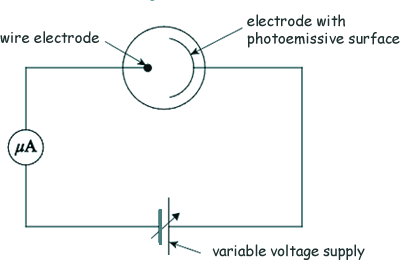Questions on the Photoelectric Effect Q11. The diagram below shows a photocell which uses the photoelectric effect to provide a current in an external circuit.
(a) Electromagnetic radiation is incident on the photoemissive surface. Explain why there is a current only if the frequency of the electromagnetic radiation is above a certain value. The energy of an incident photon [3 marks] (b) State and explain the effect on the current when the intensity of the electromagnetic radiation is increased. Increasing the intensity of the electromagnetic radiation means that more photons will be incident on the photoemissive surface per second. [2 marks] (c) Kayjay investigated the properties of the photocell. She used a source of electromagnetic radiation of fixed frequency and observed that there was a current in the external circuit. She then connected a variable voltage supply so the positive terminal was connected to the electrode with a photoemissive surface and the negative terminal was connected to the wire electrode. As she increased the supply voltage, the current decreased and eventually became zero. The minimum voltage at which this happened is called the stopping potential. Kayjay's new circuit is shown here:
The photoemissive surface had a work function of 2.1 eV. The frequency of the electromagnetic radiation Kayjay used was 7.23 × 1014 Hz.
[3 marks]
[1 mark] (d) Kayjay increases the frequency of the electromagnetic radiation she uses in her experiment. Explain the effect this has on the stopping potential. The energy of the photons (of the incident electromagnetic radiation) would be greater [3 marks] (Total 12 marks) |
Follow me...
|







